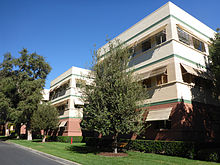Disney Renaissance
The ten feature films associated with this period are The Little Mermaid (1989), The Rescuers Down Under (1990), Beauty and the Beast (1991), Aladdin (1992), The Lion King (1994), Pocahontas (1995), The Hunchback of Notre Dame (1996), Hercules (1997), Mulan (1998), and Tarzan (1999).
[2][3] The resurgence allowed Disney's animated films to become a powerhouse of successes at the domestic and foreign box office, earning much greater profits.
One issue was that Reitherman was determined to produce only family-friendly material certain to turn a profit, and consequently he softened Disney villains so that they were more comical or pitiful than scary.
Disney made major organizational changes in the mid-1980s after narrowly escaping a hostile takeover attempt by businessman and financier Saul Steinberg.
On February 1, 1985, to make more room for Live action filmmaking, the animation department was moved from the main Disney lot in Burbank to a supposedly temporary location in various hangars, warehouses, and trailers about 2 miles (3.2 km) east in nearby Glendale, where it would remain for the next ten years.
In the interest of saving what he believed to be the studio's core business, Roy E. Disney, who resigned from the company in 1984, persuaded Eisner to let him return and supervise the animation department in the hopes of improving its fortunes.
An American Tail outperformed The Great Mouse Detective and became the highest grossing animated film to that date.
Despite The Land Before Time becoming globally the highest grossing animated film to that date, breaking the previous record of An American Tail, Oliver and Company outgrossed it in the United States, launching an era of increased theatrical turnout for Disney.
Disney moved to first place in box office receipts by 1988, with Who Framed Roger Rabbit being the summer's biggest hit.
[16] His Lupin the Third film adaptation of the animated TV series based on the Monkey Punch comics, Castle of Cagliostro (1979), influenced the climax of The Great Mouse Detective, which in turn paved the way for the Disney Renaissance.
Lyricist Howard Ashman and composer Alan Menken, who worked on Broadway years earlier on Little Shop of Horrors alongside now-Walt Disney Feature Animation president Peter Schneider (who served as company manager on the stage musical),[20] became involved in the production, writing and composing the songs and score for the film.
[25] It also marked a significant turn by the studio back towards the darker and scarier villains typical of the films it had produced before Walt Disney's death.
Rice later went on to collaborate with Elton John and Hans Zimmer for The Lion King after ABBA had turned down the offer to write songs for the film.
[38] Thanks to the success of the early films of the Renaissance era, Disney management was able to allocate sufficient money to bring Feature Animation back from its ten-year exile to Glendale.
A 240,000-square-foot building designed by Robert A. M. Stern opened across the street from the main Disney lot in Burbank on December 16, 1994.
Although it gained more positive criticism than Pocahontas and The Hunchback of Notre Dame, it was still vulnerable to competition from companies such as DreamWorks Animation and Pixar.
According to review-aggregation website Rotten Tomatoes, six of the movies—The Little Mermaid, Beauty and the Beast, Aladdin, The Lion King, Mulan, and Tarzan garnered approval ratings of over 85%, with the first four being referred to by Roger Ebert as the "big four" in 1997.
Most of the Renaissance films had songs that have the main character singing what they want out of life as well as chorus numbers led by the supporting cast.
[32] Robin Williams' performance as Genie in Aladdin is the reason why many believe other studios began to cast celebrities as voice actors in their animated films.
Brandon Zachery of Comic Book Resources states that Tarzan is widely considered to be the finale of the Renaissance as it was the final film in a row of Disney's that, "still adhered to many of the era's standard traits, including multiple songs, cutting-edge visuals and celebrity cameos in small roles.
[93] Frozen also was Walt Disney Animation Studios' first feature-length motion picture to win an Academy Award since Tarzan.
[94] Beauty and the Beast, directed by Bill Condon, was released on March 17, 2017, as the first live-action adaptation of the Disney Renaissance.
[101] Beauty and the Beast received positive reviews from critics, with many praising its faithfulness to the original animated film, the elements used from the Broadway musical, performances, visual style, musical score, songs, costume design, and production values, though criticism was drawn toward its character designs, the auto-tuning of the singing voices, and the inclusion of new Menken songs that deviated in tone from his previous creative zenith.
[102][103] Aladdin, directed and co-written by Guy Ritchie, is the second live-action Disney Renaissance adaptation theatrically released in the United States on May 24, 2019.
[113] Originally scheduled to be a wide theatrical release in March 2020, it was ultimately cancelled in the United States after being delayed multiple times due to the COVID-19 pandemic.
Vanessa Armstrong of /Film called it a live-action remake "done well" that "improves on the original" and had no doubt that "it will become an indelible part of many a young person's childhood, and I can't wait to watch it with my daughter.
"[120] Ann Hornaday of The Washington Post called it an "on-the-other-fin mixed bag of a movie that honors its source material with a big, color-saturated production, while never precisely proving that it ever needed to exist.





